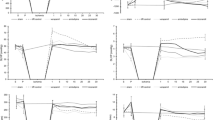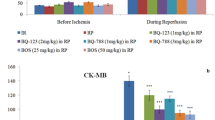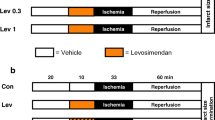Abstract
The present study is designed to investigate the role of Na+-H+ exchanger in the cardioprotective effect of ischaemic and angiotensin (Ang II) preconditioning. Isolated perfused rat heart was subjected to global ischaemia for 30 min followed by reperfusion for 120 min. Coronary effluent was analysed for LDH and CK release to assess the degree of cardiac injury. Myocardial infarct size was estimated macroscopically using TTC staining. Left ventricular developed pressure (LVDP) and dp/dt were recorded to evaluate myocardial contractility. Four episodes of ischaemic or Ang II preconditioning markedly reduced LDH and CK release in coronary effluent and decreased myocardial infarct size. 5-(N-ethyl-N-isopropyl)amiloride (EIPA), a Na+-H+ exchange inhibitor, produced no marked effect on ischaemic preconditioning and Ang II preconditioning induced cardioprotection. On the other hand, EIPA administration prior to global ischaemia produced a similar reduction in myocardial injury as was noted with ischaemic preconditioning or Ang II preconditioning. On the basis of these results, it may be concluded that inhibition of Na+-H+ exchanger protects against ischaemia-reperfusion induced myocardial injury whereas activation of Na+-H+ exchanger may not mediate the cardioprotective effect of ischaemic and Ang II preconditioning.
Similar content being viewed by others
References
Kida M, Fujiwara H, Ishida M, Kawai C, Ohura M, Miura I, Yabuuchi Y: Ischaemic preconditioning preserves creatine phosphate and intracellular pH. Circulation 84: 2495–2503, 1991
Steenbergen C, Perlman ME, London RE, Murphy E: Mechanism of preconditioning: Ionic alterations.Circ Res 72: 112–125, 1993
Wolfe CL, Sievers RE, Visseren FLJ, Donnelly TJ: Loss of myocardial protection after preconditioning correlates with the time course of glycogen recovery within the preconditioned segment. Circulation 87: 881–892, 1993
Chacko VP, Weiss RG: Intracellular pH determination by 13C NMR. Am J Physiol 2640: C755–C760, 1993
Ramasamy R, Liu H, Anderson S, Lundmark J, Schaefer S: Ischemic preconditioning stimulates sodium and proton transport in isolated rat hearts. J Clin Invest 96: 1464–1472, 1995
Kleyman TR, Cragoe EJ Jr: Amiloride and its analogs as tools in the study of ion transport. J Membr Biol 105: 1–21, 1988
Aye NN, Komori S, Hashimoto K: Effects and interaction, of cariporide and preconditioning on cardiac arrhythmias and infarction in rat in vivo. Br J Pharmacol 127: 1048–1055, 1999
Matsui H, Barry WH, Livesy C, Spitzer KW: Angiotensin II stimulates sodium-hydrogen exchange in adult rabbit ventricular myocytes. Cardiovasc Res 29: 215–221, 1995
Sharma A, Singh M: Role of angiotensin in cardioprotective effect of ischaemic preconditioning. J Cardiovasc Pharmacol 33: 772–778, 1999
Vigne P, Frelin C, Cragoe EJ Jr, Lazdunski M: Ethylisopropyl amiloride: A new and highly potent derivative of amiloride for the inhibition of the Na+/H+ exchange system in various cell types. Biochem Biophys Res Commun 116: 86–90, 1983
Langendorff O: Untersuchungen am uberlebender saugethierherzen. Pflü gers Arch 61: 291–332, 1895
Hughes BP: A method for the estimation of serum creatine kinase and aldose activity in the normal and pathological sera. Clin Chim Acta 7: 597–603, 1961
King J: A routine method for the estimation of lactic dehydrogenase activity. J Med Lab Tech 16: 265–272, 1959
Fishbein MC, Meerbaum S, Rit J, Lando U, Kanmatsuse K, Merair JC, Corday E, Ganz W: Early phase acute myocardial infarct size quantification: Validation of the triphenyltetrazolium chloride tissue enzyme staining technique. Am Heart J 101: 593–600, 1981
Chopra K, Singh M, Kaul N, Andrabi KI, Ganguly NK: Decrease of myocardial infarct size with dessferrioxamine: Possible role of oxygen free radicals in its ameliorative effect. Mol Cell Biochem 113: 71–76, 1992
Gold MR, Strichartz GR: Use-dependent block of atrial sodium current by ethylisopropylamiloride. J Cardiovasc Pharmacol 17: 792–799, 1991
Pierce GN, Cole WC, Liu K, Massaeli H, Maddaford TG, Chen YJ, McPherson CD, Jain S, Sontag D: Modulation of cardiac performance by amiloride and several selected derivatives of amiloride. J Pharmacol Exp Ther 265: 1280–1291, 1993
Murata Y, Harada K, Nakajima F, Maruo J, Morita T: Non-selective effects of amiloride and its analogues on ion transport systems and their cytotoxicities in cardiac myocytes. Jpn J Pharmacol 68: 279–285, 1995
Dennis SC, Grevers W, Opie LH: Protons in ischaemia: Where do they come from; where do they go? J Mol Cell Cardiol 23: 1077–1086, 1991
Tani M, Neely JR: Role of intracellular Na+ in Ca2+ overload and depressed recovery of ventricular function of reperfused heart: Possible involvement of Na+-H+ and Na+-Ca2+ exchange. Circ Res 65: 1045–1056, 1989
VanEmous JG, Schreur JHM, Ruigrok TJC, VanEchteld CJA: Both Na+-K+ ATPase and Na+-H+ exchanger are immediately active upon postischaemic reperfusion in isolated rat heart. J Mol Cell Cardiol 30: 337–348, 1998
Liu Y, Tsuchida A, Cohen MV, Downey JM: Pretreatment with angiotensin II activates protein kinase C and limits myocardial infarction in isolated rabbit hearts. J Mol Cell Cardiol 27: 883–892, 1995
Diaz RJ, Wilson GJ: Selective blockade of AT1 angiotensin II receptors abolishes ischaemic preconditioning in isolated rabbit hearts. J Mol Cell Cardiol 29:129–139, 1997
Munch Ellingsen J, Lkeb J E, Bugge E, Ytrehus K: Equal reduction in infarct size by ethyl isopropyl amiloride pretreatment and ischaemic preconditioning in the in situ rabbit heart. Mol Cell Biochem 186: 13–18, 1998
Xiao X, Allen DG: Role of Na+/H+ exchanger during ischaemia and preconditioning in isolated rat heart. Circ Res 85: 723–730, 1999
Author information
Authors and Affiliations
Rights and permissions
About this article
Cite this article
Sharma, A., Singh, M. Effect of ethylisopropyl amiloride, a Na+-H+ exchange inhibitor, on cardioprotective effect of ischaemic and angiotensin preconditioning. Mol Cell Biochem 214, 31–38 (2000). https://doi.org/10.1023/A:1007167519596
Issue Date:
DOI: https://doi.org/10.1023/A:1007167519596




